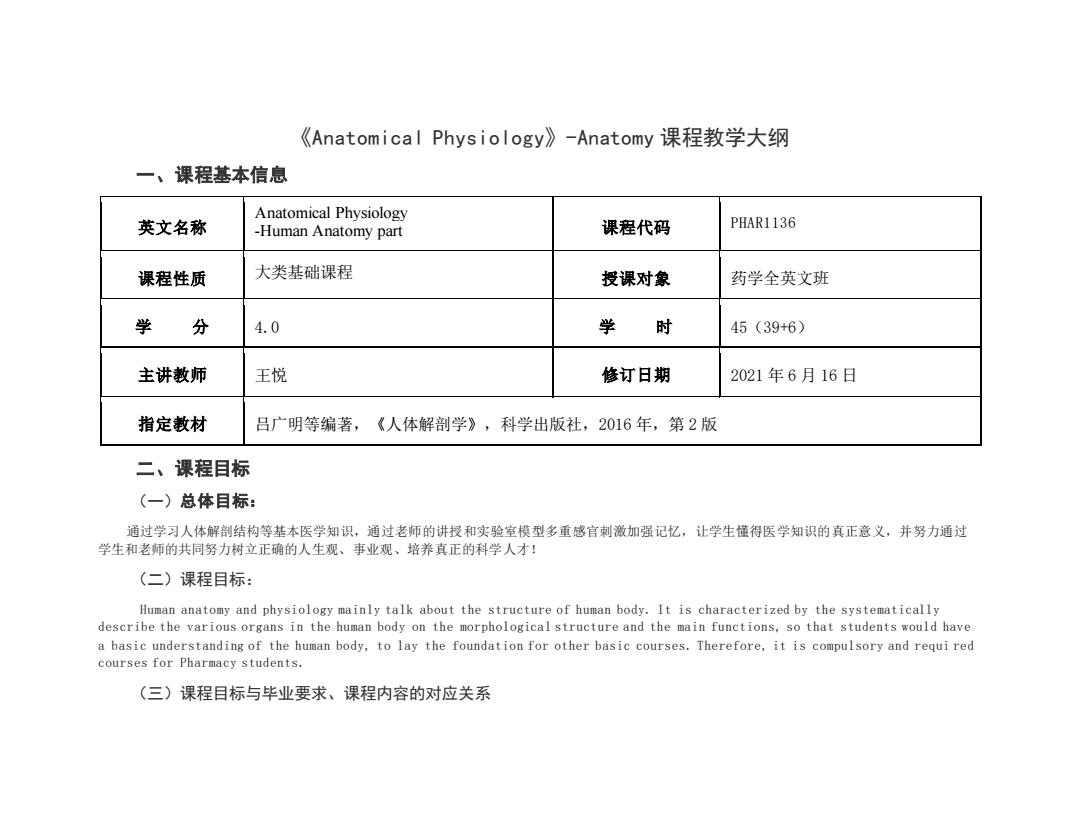
《Anatomical Physiology,》-Anatomy课程教学大纲 一、课程基本信息 Anatomical Physiology 英文名称 -Human Anatomy part 课程代码 PHAR1136 课程性质 大类基础课程 授课对象 药学全英文班 学 分 4.0 学 时 45(39+6) 主讲教师 王悦 修订日期 2021年6月16日 指定教材 吕广明等编著,《人体解剖学》,科学出版社,2016年,第2版 二、课程目标 (一)总体目标: 通过学习人体解剖结构等基本医学知识,通过老师的讲授和实验室模型多重感官刺激加强记忆,让学生懂得医学知识的真正意义,并努力通过 学生和老师的共同努力树立正确的人生观、事业观、培养真正的科学人才! (二)课程目标: Human anatomy and physiology mainly talk about the structure of human body.It is characterized by the systematically describe the various organs in the human body on the morphological structure and the main functions,so that students would have a basic understanding of the human body,to lay the foundation for other basic courses.Therefore,it is compulsory and requi red courses for Pharmacy students. (三)课程目标与毕业要求、课程内容的对应关系
《Anatomical Physiology》-Anatomy 课程教学大纲 一、课程基本信息 英文名称 Anatomical Physiology -Human Anatomy part 课程代码 PHAR1136 课程性质 大类基础课程 授课对象 药学全英文班 学 分 4.0 学 时 45(39+6) 主讲教师 王悦 修订日期 2021 年 6 月 16 日 指定教材 吕广明等编著,《人体解剖学》,科学出版社,2016 年,第 2 版 二、课程目标 (一)总体目标: 通过学习人体解剖结构等基本医学知识,通过老师的讲授和实验室模型多重感官刺激加强记忆,让学生懂得医学知识的真正意义,并努力通过 学生和老师的共同努力树立正确的人生观、事业观、培养真正的科学人才! (二)课程目标: Human anatomy and physiology mainly talk about the structure of human body. It is characterized by the systematically describe the various organs in the human body on the morphological structure and the main functions, so that students would have a basic understanding of the human body, to lay the foundation for other basic courses. Therefore, it is compulsory and requi red courses for Pharmacy students. (三)课程目标与毕业要求、课程内容的对应关系
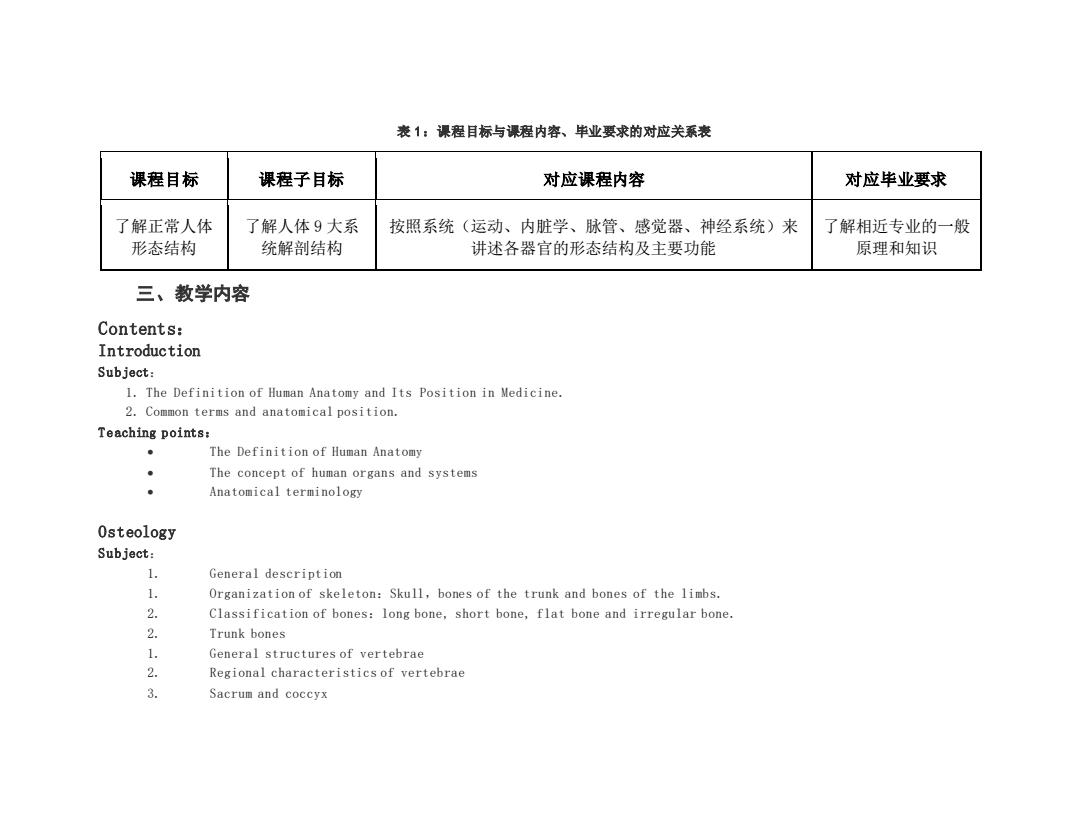
表1:课程目标与课程内容、单业要求的对应关系表 课程目标 课程子目标 对应课程内容 对应毕业要求 了解正常人体 了解人体9大系 按照系统(运动、内脏学、脉管、感觉器、神经系统)来 了解相近专业的一般 形态结构 统解剖结构 讲述各器官的形态结构及主要功能 原理和知识 三、教学内容 Contents: Introduction Subject: 1.The Definition of Human Anatomy and Its Position in Medicine. 2.Common terms and anatomical position. Teaching points: The Definition of Human Anatomy The concept of human organs and systems Anatomical terminology Osteology Subject: 1. General description 1. Organization of skeleton:Skull,bones of the trunk and bones of the limbs. 2. Classification of bones:long bone,short bone,flat bone and irregular bone. 2. Trunk bones 1. General structures of vertebrae 2. Regional characteristics of vertebrae 3. Sacrum and coccyx
表 1:课程目标与课程内容、毕业要求的对应关系表 课程目标 课程子目标 对应课程内容 对应毕业要求 了解正常人体 形态结构 了解人体 9 大系 统解剖结构 按照系统(运动、内脏学、脉管、感觉器、神经系统)来 讲述各器官的形态结构及主要功能 了解相近专业的一般 原理和知识 三、教学内容 Contents: Introduction S u bject: 1. The Definition of Human Anatomy and Its Position in Medicine. 2. Common terms and anatomical position. T e aching p oints: • The Definition of Human Anatomy • The concept of human organs and systems • Anatomical terminology Osteology S u bject: 1. General description 1. Organization of skeleton:Skull,bones of the trunk and bones of the limbs. 2. Classification of bones:long bone, short bone, flat bone and irregular bone. 2. Trunk bones 1. General structures of vertebrae 2. Regional characteristics of vertebrae 3. Sacrum and coccyx
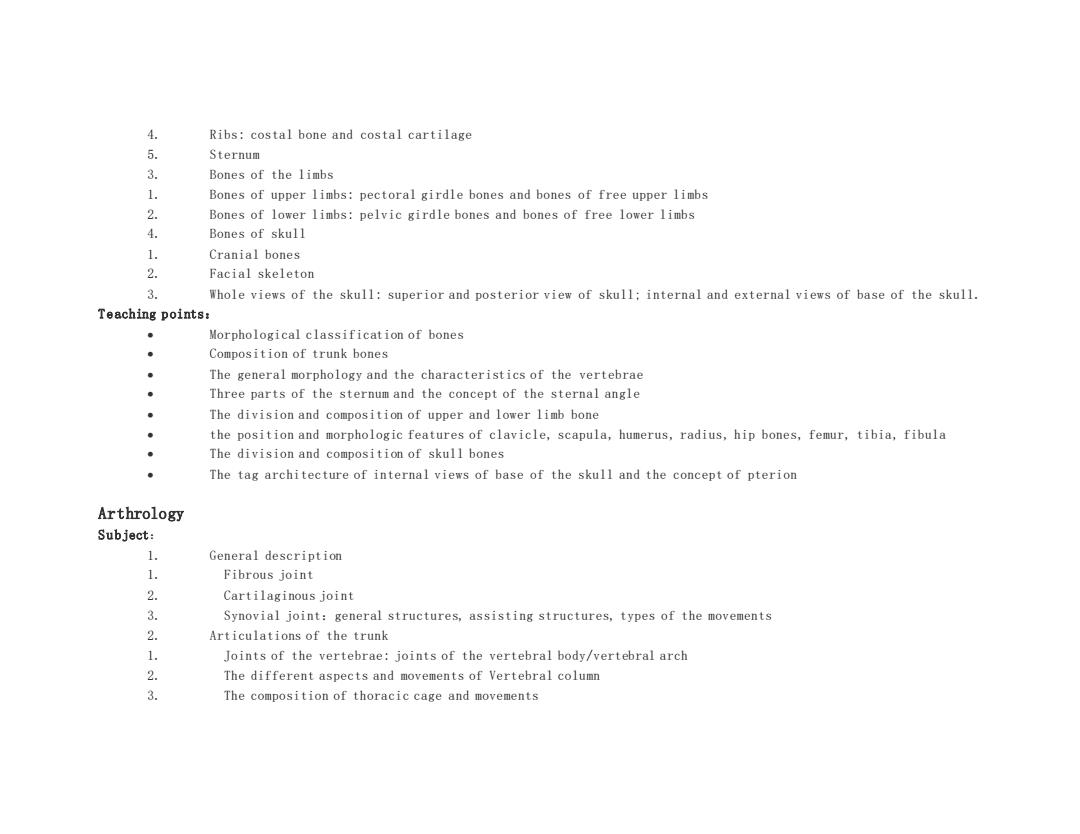
4 Ribs:costal bone and costal cartilage 5. Sternum 3. Bones of the limbs Bones of upper limbs:pectoral girdle bones and bones of free upper limbs 2. Bones of lower limbs:pelvic girdle bones and bones of free lower limbs 4. Bones of skull 1. Cranial bones 2. Facial skeleton 3. Whole views of the skull:superior and posterior view of skull;internal and external views of base of the skull. Teaching points: Morphological classification of bones Composition of trunk bones The general morphology and the characteristics of the vertebrae Three parts of the sternum and the concept of the sternal angle The division and composition of upper and lower limb bone the position and morphologic features of clavicle,scapula,humerus,radius,hip bones,femur,tibia,fibula The division and composition of skull bones The tag architecture of internal views of base of the skull and the concept of pterion Arthrology Subject: 1. General description 1. Fibrous joint 2. Cartilaginous joint 3. Synovial joint:general structures,assisting structures,types of the movements 2. Articulations of the trunk 1. Joints of the vertebrae:joints of the vertebral body/vertebral arch 2. The different aspects and movements of Vertebral column 3. The composition of thoracic cage and movements
4. Ribs: costal bone and costal cartilage 5. Sternum 3. Bones of the limbs 1. Bones of upper limbs: pectoral girdle bones and bones of free upper limbs 2. Bones of lower limbs: pelvic girdle bones and bones of free lower limbs 4. Bones of skull 1. Cranial bones 2. Facial skeleton 3. Whole views of the skull: superior and posterior view of skull; internal and external views of base of the skull. T e aching p oints: • Morphological classification of bones • Composition of trunk bones • The general morphology and the characteristics of the vertebrae • Three parts of the sternum and the concept of the sternal angle • The division and composition of upper and lower limb bone • the position and morphologic features of clavicle, scapula, humerus, radius, hip bones, femur, tibia, fibula • The division and composition of skull bones • The tag architecture of internal views of base of the skull and the concept of pterion Arthrology S u bject: 1. General description 1. Fibrous joint 2. Cartilaginous joint 3. Synovial joint:general structures, assisting structures, types of the movements 2. Articulations of the trunk 1. Joints of the vertebrae: joints of the vertebral body/vertebral arch 2. The different aspects and movements of Vertebral column 3. The composition of thoracic cage and movements
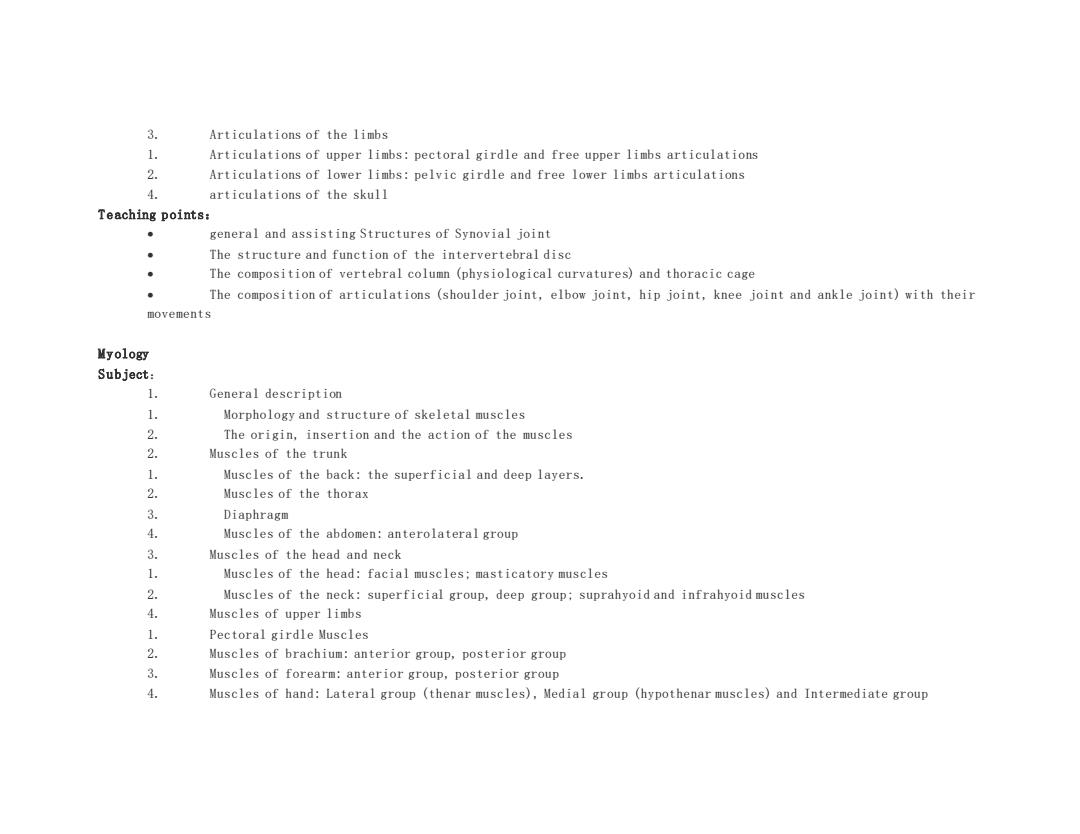
3. Articulations of the limbs 1. Articulations of upper limbs:pectoral girdle and free upper limbs articulations 2. Articulations of lower limbs:pelvic girdle and free lower limbs articulations 4. articulations of the skull Teaching points: general and assisting Structures of Synovial joint The structure and function of the intervertebral disc The composition of vertebral column (physiological curvatures)and thoracic cage The composition of articulations (shoulder joint,elbow joint,hip joint,knee joint and ankle joint)with their movements Myology Subject: 1. General description 1. Morphology and structure of skeletal muscles 2. The origin,insertion and the action of the muscles 2. Muscles of the trunk 1. Muscles of the back:the superficial and deep layers. 2. Muscles of the thorax 3. Diaphragm 4. Muscles of the abdomen:anterolateral group 3. Muscles of the head and neck 1. Muscles of the head:facial muscles;masticatory muscles 2. Muscles of the neck:superficial group,deep group:suprahyoid and infrahyoid muscles 4. Muscles of upper limbs 1. Pectoral girdle Muscles 2. Muscles of brachium:anterior group,posterior group 3. Muscles of forearm:anterior group,posterior group 4. Muscles of hand:Lateral group (thenar muscles),Medial group (hypothenar muscles)and Intermediate group
3. Articulations of the limbs 1. Articulations of upper limbs: pectoral girdle and free upper limbs articulations 2. Articulations of lower limbs: pelvic girdle and free lower limbs articulations 4. articulations of the skull T e aching p oints: • general and assisting Structures of Synovial joint • The structure and function of the intervertebral disc • The composition of vertebral column (physiological curvatures) and thoracic cage • The composition of articulations (shoulder joint, elbow joint, hip joint, knee joint and ankle joint) with their movements M y ology S u bject: 1. General description 1. Morphology and structure of skeletal muscles 2. The origin, insertion and the action of the muscles 2. Muscles of the trunk 1. Muscles of the back: the superficial and deep layers. 2. Muscles of the thorax 3. Diaphragm 4. Muscles of the abdomen: anterolateral group 3. Muscles of the head and neck 1. Muscles of the head: facial muscles; masticatory muscles 2. Muscles of the neck: superficial group, deep group; suprahyoid and infrahyoid muscles 4. Muscles of upper limbs 1. Pectoral girdle Muscles 2. Muscles of brachium: anterior group, posterior group 3. Muscles of forearm: anterior group, posterior group 4. Muscles of hand: Lateral group (thenar muscles), Medial group (hypothenar muscles) and Intermediate group
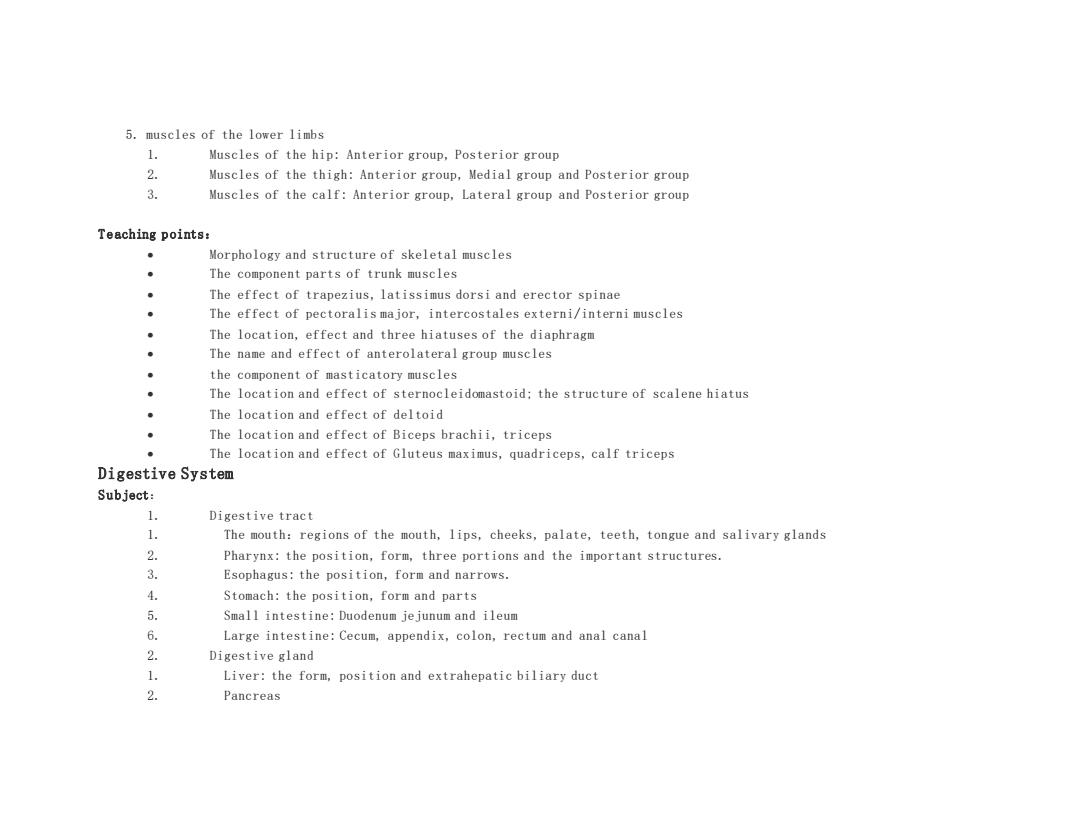
5.muscles of the lower limbs 1. Muscles of the hip:Anterior group,Posterior group 2. Muscles of the thigh:Anterior group,Medial group and Posterior group 3. Muscles of the calf:Anterior group,Lateral group and Posterior group Teaching points: Morphology and structure of skeletal muscles The component parts of trunk muscles The effect of trapezius,latissimus dorsi and erector spinae The effect of pectoralis major,intercostales externi/interni muscles The location,effect and three hiatuses of the diaphragm The name and effect of anterolateral group muscles the component of masticatory muscles The location and effect of sternocleidomastoid:the structure of scalene hiatus The location and effect of deltoid The location and effect of Biceps brachii,triceps The location and effect of Gluteus maximus,quadriceps,calf triceps Digestive System Subject: 1. Digestive tract 1. The mouth:regions of the mouth,lips,cheeks,palate,teeth,tongue and salivary glands 2. Pharynx:the position,form,three portions and the important structures. Esophagus:the position,form and narrows. 4. Stomach:the position,form and parts 5. Small intestine:Duodenum jejunum and ileum 6. Large intestine:Cecum,appendix,colon,rectum and anal canal 2. Digestive gland 1. Liver:the form,position and extrahepatic biliary duct 2. Pancreas
5. muscles of the lower limbs 1. Muscles of the hip: Anterior group, Posterior group 2. Muscles of the thigh: Anterior group, Medial group and Posterior group 3. Muscles of the calf: Anterior group, Lateral group and Posterior group T e aching p oints: • Morphology and structure of skeletal muscles • The component parts of trunk muscles • The effect of trapezius, latissimus dorsi and erector spinae • The effect of pectoralis major, intercostales externi/interni muscles • The location, effect and three hiatuses of the diaphragm • The name and effect of anterolateral group muscles • the component of masticatory muscles • The location and effect of sternocleidomastoid; the structure of scalene hiatus • The location and effect of deltoid • The location and effect of Biceps brachii, triceps • The location and effect of Gluteus maximus, quadriceps, calf triceps Digestive System S u bject: 1. Digestive tract 1. The mouth:regions of the mouth, lips, cheeks, palate, teeth, tongue and salivary glands 2. Pharynx: the position, form, three portions and the important structures. 3. Esophagus: the position, form and narrows. 4. Stomach: the position, form and parts 5. Small intestine: Duodenum jejunum and ileum 6. Large intestine: Cecum, appendix, colon, rectum and anal canal 2. Digestive gland 1. Liver: the form, position and extrahepatic biliary duct 2. Pancreas